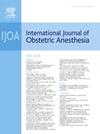选择性剖宫产颅脑外伤和脊髓麻醉后硬膜下血肿一例报告。
IF 2.3
3区 医学
Q2 ANESTHESIOLOGY
引用次数: 0
摘要
硬膜下血肿是产科脊髓麻醉中一种罕见但危及生命的并发症。我们报告一个病例急性硬膜下血肿脊髓麻醉后择期剖宫产可能促进再出血从一个未被识别的预备头部创伤。一位健康的32岁初产妇(ASA II)在27号昆克针的脊髓麻醉下接受了剖宫产。围手术期进展顺利;然而,术后30小时,患者突然出现严重的额眶头痛,随后意识渐进式恶化和斜视。急诊神经影像显示急性左颞硬膜下血肿伴额顶叶延伸及肿块效应。进一步的病史调查显示,在分娩前一周发生了以前未报道的轻微头部创伤。患者在一小时内通过开颅手术紧急撤离,导致神经系统迅速改善。术后第三天,患者的神经功能完全恢复。这一临床表现支持双重打击机制:最初由轻微创伤引起的桥静脉损伤形成了缺乏症状的集合;脊髓性脑脊液低血压增加静脉牵引,诱发再出血,放大肿块效应。本病例强调了细致的麻醉前病史记录的重要性,特别是关于近期头部创伤的产科患者计划进行神经轴麻醉。建议使用铅笔尖的小尺寸脊髓针,以尽量减少硬脑膜穿刺和随后的脑脊液漏的风险。对非典型硬脑膜穿刺后头痛保持警惕,及时进行神经影像学检查和紧急神经外科干预是观察到良好神经预后的关键。本文章由计算机程序翻译,如有差异,请以英文原文为准。
Subdural hematoma following head trauma and spinal anesthesia for elective cesarean delivery: a case report
Subdural hematoma is a rare but life-threatening complication of obstetric spinal anesthesia. We report a case of acute subdural hematoma following spinal anesthesia for elective cesarean delivery that likely promoted rebleeding from an unrecognized prepartum head trauma. A healthy 32-year-old primiparous patient (ASA II) underwent a cesarean delivery with spinal anesthesia performed with a 27-gauge Quincke needle. The perioperative course was uneventful; however thirty hours postoperatively, the patient developed a sudden severe fronto-orbital headache followed by progressive deterioration in consciousness and anisocoria. Emergency neuroimaging revealed an acute left temporal subdural hematoma with frontoparietal extension and mass effect. Further history-taking revealed a previously unreported minor head trauma one week prior to delivery. The patient underwent urgent surgical evacuation via craniectomy within one hour, resulting in rapid neurological improvement. By postoperative day three, the patient had made a full neurological recovery. This clinical presentation supports a two-hit mechanism: initial bridging-vein injury from minor trauma formed a pauci-symptomatic collection; spinal-induced cerebrospinal fluid hypotension then increased venous traction, precipitating rebleeding, amplifying mass effect.
This case underscores the importance of meticulous pre-anesthetic history-taking, particularly regarding recent head trauma, in obstetric patients scheduled for neuraxial anesthesia. The use of pencil-point small-gauge spinal needles is recommended to minimize the risk of dural puncture and subsequent cerebrospinal fluid leakage. Vigilance for atypical post-dural puncture headache, prompt neuroimaging, and urgent neurosurgical intervention were key to the favorable neurological outcome observed.
求助全文
通过发布文献求助,成功后即可免费获取论文全文。
去求助
来源期刊
CiteScore
4.70
自引率
7.10%
发文量
285
审稿时长
58 days
期刊介绍:
The International Journal of Obstetric Anesthesia is the only journal publishing original articles devoted exclusively to obstetric anesthesia and bringing together all three of its principal components; anesthesia care for operative delivery and the perioperative period, pain relief in labour and care of the critically ill obstetric patient.
• Original research (both clinical and laboratory), short reports and case reports will be considered.
• The journal also publishes invited review articles and debates on topical and controversial subjects in the area of obstetric anesthesia.
• Articles on related topics such as perinatal physiology and pharmacology and all subjects of importance to obstetric anaesthetists/anesthesiologists are also welcome.
The journal is peer-reviewed by international experts. Scholarship is stressed to include the focus on discovery, application of knowledge across fields, and informing the medical community. Through the peer-review process, we hope to attest to the quality of scholarships and guide the Journal to extend and transform knowledge in this important and expanding area.

 求助内容:
求助内容: 应助结果提醒方式:
应助结果提醒方式:


